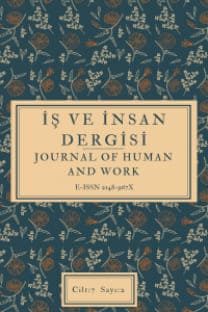İşe Tutulma Ölçeği Çok Kısa Versiyonu (UWES-3) Geçerlilik ve Güvenilirlik Çalışması: Alternatif Bir Versiyon (UWES-6) Önerisi
Bu araştırmada İşe Tutulma Ölçeğinin (UWES-9) üç maddeye (UWES-3) kısaltılmış versiyonunun Türk kültürel bağlamında geçerlilik ve güvenilirlik çalışması yapılmıştır. Ayrıca 9 maddelik formda orijinal çalışmada da tespit edilen yapısal problemlere yönelik olarak işe tutulma ölçeğinin altı maddelik alternatif bir versiyonu incelenmiştir. Anket yöntemiyle 434 katılımcıdan toplanan veri kullanılarak yapılan analizler sonucunda İşe Tutulma Ölçeğinin üç maddeli çok kısa versiyonu yapısal olarak geçerli ve güvenilir bulunmuş ayrıca ölçeğin dokuz maddeli versiyonu ile benzer ölçüm değerleri sağladığı görülmüştür. Diğer yandan işe tutulma ölçeğinin üç alt boyutuyla birlikte ölçülmesi amaçlandığında yapısal geçerliliğe yönelik bazı problemli maddelere sahip dokuz maddeli ölçek versiyonu yerine 3 boyutlu 6 maddeli versiyonun (UWES-6) yapısal olarak daha iyi değerler sağladığı tespit edilmiştir. Araştırma sonucunda Türkiye’de yapılacak çalışmalarda işe tutulmanın en az maddeyle tek boyutlu bir yapı olarak ölçülmesinin istenildiği hallerde üç maddeli formun kullanılabileceği, üç alt boyutlu olarak ölçülmek istendiğinde ise altı maddelik versiyonun kullanılabileceği önerilmiştir.
Anahtar Kelimeler:
İşe Tutulma Ölçeği, UWES-9, UWES-3, UWES-6, Geçerlilik, Geçerlilik
The Validity and Reliability Study of Work Engagement Ultra Short Version (UWES-3) Proposal of an Alternative Version (UWES-6)
In this research, the validity and reliability study of the ultra-short three-item version (UWES-3) of Work Engagement Scale (UWES-9) was conducted for the Turkish culture and an alternative six-item version was proposed. As a result of the analysis based on the collected data from 434 participants by questionnaire method, it was seen that the three-item short version was structurally valid and reliable and also provided similar measurement values compared to the nine-item version. Also, the 6-item version (with 3 sub-dimensions) of work engagement scale (UWES-6) provided structurally better validity values than the nine-item scale when the research interest is to measure engagement with sub-dimensions. Finally, it is suggested that the 3-item ultra-short version of UWES is applicable for measuring job engagement briefly with a single factor, and the 6-item version of UWES is better for measuring job engagement regarding its sub-dimensions in the Turkish context.
Keywords:
Work Engagement Scale, UWES-9, UWES-3, UWES-6, Validation,
___
- Basım, H. N. & Şeşen, H. (2009). Örgütsel adalet algısı-örgütsel vatandaşlık davranışı ilişkisinde iş tatmininin aracılık rolü. On yedinci Yönetim ve Organizasyon Kongresi’nde sunulan bildiri, Eskişehir, 21-23 Mayıs, 2009.
- Bollen, K. A. (1989). Structural equations with latent variables. New York: Wiley.
- Britt, T. W., Dickinson, J. M., Greene, T. M. & Mckibben, E. (2007). Self engagement at work. In, C. L. Cooper & D. Nelson (Eds.), Positive organizational behavior: Accentuating the positive at work. Sage: Thousand Oaks. CA.
- Byrne, B. M. (2009). Structural equation modeling with AMOS (2nd ed.). Mahwah, NJ: Erlbaum.
- Eryılmaz, E. & Doğan, T. (2012). İş yaşamında öznel iyi oluş: Utrecht İşe Bağlılık Ölçeğinin psikometrik niteliklerinin incelenmesi, Klinik Psikiyatri, 15, 49-55.
- Farndale, E., Beijer, S. E., Van Veldhoven, M. J., Kelliher, C. & Hope-Hailey, V. (2014). Work and organization engagement: Aligning research and practice, Journal of Organizational Effectiveness: People and Performance, 1, 157–176.
- Hackman, R. & Oldham, G. R. (1975). Development of the Job Diagnostic Survey, Journal of Applied Psychology, 60(2), 159-170.
- Hu, L. & Bentler, P. M. (1999). Cutoff criteria for FIT indexes in covariance structure analysis: conventional criteria versus new alternatives. SEM, 6(1), 1-55.
- Judge, T. A., Erez, A., Bono, J. E. & Thoresen, C. J. (2003). The core self-evaluations scale: Development of a measure, Personnel Psychology, 56, 303–331.
- Judge, T. A., Locke, E. A. & Durham, C. C. (1997). The dispositional causes of job satisfaction: A core evaluations approach. In, L. L. Cummings & B. M. Staw (Ed.), Research in Organizational Behavior, 19, 151-188. Greenwich, CT: JAI Press.
- Kahn, W. A. (1990). Psychological conditions of personal engagement and disengagement at work. Academy of Management Journal, 33, 692-724.
- Meydan, C. H. & Şeşen H. (2011). Yapısal eşitlik modellemesi AMOS uygulamaları, Ankara: Detay Yayıncılık.
- Özkalp, E. & Meydan, B. (2015). Schaufeli ve Bakker tarafından geliştirilmiş olan İşe Angaje Olma Ölçeğinin Türkçe’de güvenilirlik ve geçerliliğinin analizi, İş, Güç Endüstri İlişkileri ve İnsan Kaynakları Dergisi, 17(3), 04-19.
- Rich, B. L., Lepine, J. A. & Crawford, E. R. (2010). Job engagement: Antecedents and effects on job performance, Academy of Management Journal, 53(3), 617-635).
- Salanova, M., Agut, S. & Peiro, J. M. (2005). Linking organizational resources and work engagement to employee performance and customer loyalty: the mediation of service climate. Journal of Applied Psychology, 90, 1217-1227.
- Schaufeli, W. B., Bakker, A. B. & Salanova, M. (2006). The measurement of work engagement with a short questionnaire a cross-national study. Educational and Psychological Measurement, 66(4), 701-716.
- Schaufeli, W. B., Salanova, M., Gonzalez-Romá, V. & Bakker, A. B. (2002). The measurement of engagement and burnout: A confirmative analytic approach. Journal of Happiness Studies, 3, 71-92.
- Schaufeli, W. B., Shimazu, A., Hakanen, J., Salanova, M. & De Witte, H. (2017). An Ultra-Short Measure for Work Engagement: The UWES-3 validation across five countries. European Journal of Psychological Assessment. (Advance online publication).
- Şeşen, H. (2010). Öncülleri ve sonuçları ile örgüt içi girişimcilik: Türk Savunma Sanayinde bir araştırma. (Yayınlanmamış Doktora Tezi). Kara Harp Okulu, Savunma Bilimleri Enstitüsü, Ankara.
- Tims M., Akkermans, J. (2017). Core self-evaluations and work engagement: Testing a perception, action, and development path. PLoS ONE, 12(8), 1-19.
- Yayın Aralığı: Yılda 2 Sayı
- Başlangıç: 2014
- Yayıncı: Faruk Şahin
Sayıdaki Diğer Makaleler
Sağlık Çalışanları Arasında Panoptik Korku
Hüseyin DEMİR, Yılmaz DEMİRHAN
Murat GÜLER, Fatih ÇETİN, H. Nejat BASIM
Alper ASLAN, Saim ASLAN, Umut AVCI
Ayşe İpek KOCA BALLI, Kemal Can KILIÇ
Dönüştürücü Liderliğin İş Becerikliliği Üzerindeki Etkisi: Akademisyenler Üzerinde Bir Uygulama
Örgütlerde Yeşil İnsan Kaynakları Yönetimi Uygulamaları: Teorik Bir İnceleme
